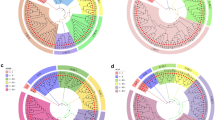Abstract
Simple, reliable methods for identification of species are required for management of many species and lines in a plant gene bank. Species-specific probes were designed from published sequences of the ITS1 region in rDNA of 16 species in Brassica and its related genera, and used as probes for dot-blot hybridization with plant genomic DNA. All the probes detected species-specific signals at dot-blots of genomic DNAs of the 16 species in Brassica, Diplotaxis, Eruca, and Raphanus. Signals of the Brassica digenomic species in the U’s triangle, i.e., B. napus, B. juncea, and B. carinata, were detected by the probes of their parental monogenomic species, i.e., B. rapa, B. nigra, and B. oleracea. The probe for B. oleracea showed signals of B. balearica, B. cretica, B. incana, B. insularis, and B. macrocarpa, which have the C genome as B. oleracea. Eruca vesicaria DNA was detected by the probe for E. sativa, which has been classified as a subspecies of E. vescaria. DNA of leaf tissue extracted by an alkaline solution and seed DNA prepared by the NaI method can be used directly for dot-blotting. Misidentification of species was revealed in 20 accessions in the Tohoku University Brassica Seed Bank. These results indicate dot-blot hybridization to be a simple and efficient technique for identification of plant species in a gene bank.


Similar content being viewed by others
References
Bailey AM, Mitchell DJ, Manjunath KL, Nolasco G, Niblett CL (2002) Identification to the species level of the plant pathogens Phytophthora and Pythium by using unique sequence of the ITS1 region of ribosomal DNA as capture probe for PCR ELISA. FEMS Microbiol Lett 207:153–158
Brace J, Ockendon KingGJ (1993) Development of a method for the identification of S alleles in Brassica oleracea based on digestion of PCR-amplified DNA with restriction endonucleases. Sex Plant Reprod 6:133–138
Chase MW, Soltis E, Olmstead RG, Morgan D, Les DH, Mishler BD, Duvall MR, Price RA, Hills HG, Qiu YL, Kron KA, Rettig JH, Conti E, Palmer JD, Manhart JR, Sytsma KJ, Hedren M, Gaut BS, Jansen RK, Kim KJ, Wimpee CF, Smith JF, Furnier GR, Strauss SH, Xiang QY, Plunkett GM, Soltis PS, Swensen SM, Williams SE, Gadek PA, Quinn CJ, Eguiarte LE, Golenberg E, Learn GH Jr, Graham SW, Barrett SCH, Dayanandan S, Albert VA (1993) Phylogenetics of seed plants: an analysis of nucleotide sequences from the plastid gene rbcL. Ann Missouri Bot Garden 80:528–580
Cluster PD, Calderini O, Pupilli F, Crea F, Damiani F, Arcioni S (1996) The fate of ribosomal genes in three interspecific somatic hybrids of Medicago sativa: three different outcomes including the rapid amplification of new spacer-length variants. Theor Appl Genet 93:801–808
Davis JI, Stevenson DW, Petersen G, Seberg O, Campbell LM, Freudenstein V, Goldman DH, Hardy CR, Michelangeli FA, Simmons MP, Specht CD, Silva FV, Gandolfo M (2004) A phylogeny of the Monocots, as inferred from rbcL and atpA sequence variation, and a comparison of methods for calculating jackknife and bootstrap values. System Bot 29:467–510
Edwards K, Johnstone C, Thompson C (1991) A simple and rapid method for the preparation of plant genomic DNA for PCR analysis. Nucl Acids Res 19:1349
Fukui K, Mukai Y, Kakeda K (1986) Analysis and utility of chromosome information. 15 identification of small plant chromosome by the condensation pattern. Jpn J Genet 61:574
Gomez-Campo C (1999) Taxonomy. In: Gomez-Campo C (ed) Biology of Brassica coenospecies. Elsevier Science B. V, Amsterdam, pp 3–32
Inaba R, Nishio T (2002) Phylogenetic analysis of Brassiceae based on the nucleotide sequence of the S-locus related gene, SLR1. Theor Appl Genet 105:1159–1165
Li G, Hu W, Qin R, Jin H, Tan G, Zhu L, He G (2008) Simple sequence repeat analyses of interspecific hybrids and MAALs of Oryza officinalis and Oryza sativa. Genetica 134:169–180
Lievens B, Brouwer M, Vanacher ACRC, Cammue BPA, Thomma BPHJ (2006) Real-time PCR for detection and quantification of fungal and oomycete tomato pathogens in plant and soil samples. Plant Sci 171:155–165
Park SH, Itoh K (2005) Species-specific oligonucleotide probes for the detection and identification of Lactobacillus isolated from mouse faeces. J Appl Microbiol 99:51–57
Sakamoto K, Kushaba M, Nishio T (2000) Single-seed PCR-RFLP analysis for the identification of S haplotypes in commercial F1 hybrid cultivars of broccoli and cabbage. Plant Cell Rep 19:400–406
Shiokai S, Shirasawa K, Sato Y, Nishio T (2010) Improvement of the dot-blot-SNP technique for efficient and cost-effective genotyping. Mol Breed 25:179–185
Song G, Sang T, Lu B, Hong D (2001) Rapid and reliable identification of rice genomes by RFLP analysis of PCR-amplified Adh genes. Genome 44:1136–1142
Song X, Wang Z, Zuo J, Huangfu C, Qlang S (2010) Potential gene flow of two herbicide-tolerant transgenes from oilseed rape to wild B. juncea var. gracilis. Theor Appl Genet 120:1501–1510
Xiao M, Kong F, Sorrell TC, Cao Y, Lee OC, Liu Y, Sintchenko V, Chen SCA (2010) Identification of pathogenic Nocardia species by reverse line blot hybridization targeting the 16S rRNA and 16S–23S rRNA gene spacer regions. J Clin Microbiol 48:503–511
Yamanaka H, Kuginuki Y, Kanno T, Nishio T (1992) Efficient production of somatic hybrids between Raphanus sativus and Brassica oleracea. Jpn J Breed 42:329–339
Acknowledgments
This work was supported in part by a Grant-in-Aid for Scientific Research (A) (no. 19208001) from the Japan Society for the Promotion of Science (JSPS) and the Program for Promotion of Basic and Applied Researches for Innovations in Bio-oriented Industry (BRAIN).
Author information
Authors and Affiliations
Corresponding author
Additional information
Communicated by C. Quiros.
Electronic supplementary material
Below is the link to the electronic supplementary material.
Rights and permissions
About this article
Cite this article
Tonosaki, K., Nishio, T. Identification of species in tribe Brassiceae by dot-blot hybridization using species-specific ITS1 probes. Plant Cell Rep 29, 1179–1186 (2010). https://doi.org/10.1007/s00299-010-0904-y
Received:
Revised:
Accepted:
Published:
Issue Date:
DOI: https://doi.org/10.1007/s00299-010-0904-y




